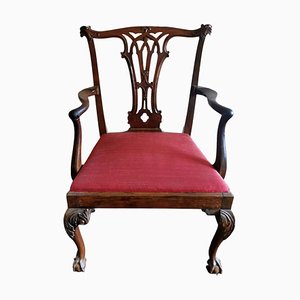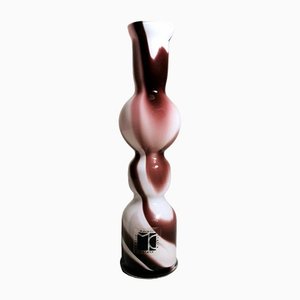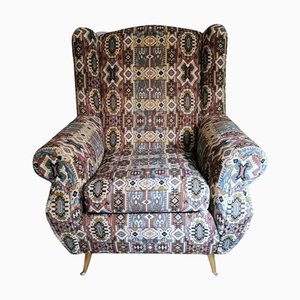We kindly invite you to read the entire , as we try to provide you with detailed technical and historical information to ensure the authenticity of our objects. A sober and linear English silver-plated teapot-chocolate bowl; the softly curved elongated form of rich elegance is supported by four cast feet; the spout and handle also have a very refined design; on the lid is fixed a cast cyma representing a small fruit with leaves. On the bottom the teapot bears the stamp of the James Dixon Company of Sheffield, with the classic trumpet with banner and the full name; from these elements, we can tell that the object was made between 1890 and 1895 in Dixon's factory in Sheffield. James Dixon and Sons was founded in Sheffield, England, in 1806 and was one of the leading British manufacturers of the Industrial Revolution, helping to give the city its global reputation for manufacturing excellence. Initially working with pewter, electroplated, Britannia Metal, and nickel silver, the company honed its skills over the years and became synonymous with sterling silver and silver-plated cutlery and hollowware. Established customers around the world, from consulates to royal families, have always been the company's clientele; their demand for the highest quality has always been the benchmark for the workshops. The company exhibited at the Great Exhibition of 1851, receiving numerous awards in different classes for silver and Britannia metal. Dixon's 1879 cost book includes designs by Christopher Dresser, recorded from 1880, which were produced until at least 1895, according to the trade catalog published that year. The first corporate trademark of the trumpet and banner was granted in 1879, while the second with the name was added in 1890. Some authors claim that the trumpet and banner trademark was officially registered in 1881, although it was already in use before then. In the 1920s the company began to use stainless steel for the production of flat and hollowware, and production of silver and silver-plated wares declined. The stainless steel spoons and forks produced by James Dixon & Son bore the names “staybrite” and “Firth,” since Firth Brown was the company where “staybrite” steel had been invented in the 1910s.
In 1920 the company was converted into a limited liability company, and in 1930 William Hutton & Sons Ltd of Sheffield was absorbed by James Dixon & Sons Ltd. In the 1980s the company had a financial meltdown and production at Cornish Place closed in 1992. The teapot is in good condition. Measures width cm.26, depth cm.12, height cm.25.
Vi invitiamo a leggere l'intero documento, in quanto cerchiamo di fornire informazioni tecniche e storiche dettagliate per garantire l'autenticità dei nostri oggetti. Teiera-cioccolatiera inglese in argento, sobria e lineare; la forma allungata e morbidamente incurvata, di ricca eleganza, è sostenuta da quattro piedini fusi; anche il beccuccio e il manico hanno un disegno molto raffinato; sul coperchio è fissata una cimasa fusa raffigurante un piccolo frutto con foglie. Sul fondo la teiera reca il timbro della James Dixon Company di Sheffield, con la classica tromba con stendardo e il nome completo; da questi elementi si evince che l'oggetto è stato realizzato tra il 1890 e il 1895 nella fabbrica di Dixon a Sheffield. James Dixon and Sons fu fondata a Sheffield, in Inghilterra, nel 1806 e fu uno dei principali produttori britannici della Rivoluzione industriale, contribuendo a dare alla città la sua reputazione globale di eccellenza manifatturiera. Inizialmente impegnata nella lavorazione del peltro, del metallo galvanico, del Britannia Metal e dell'argento al nichel, l'azienda ha affinato le sue capacità nel corso degli anni ed è diventata sinonimo di posate e oggetti cavi in argento sterling e placcati in argento. Clienti affermati in tutto il mondo, dai consolati alle famiglie reali, sono sempre stati la clientela dell'azienda; la loro richiesta di massima qualità è sempre stata il punto di riferimento per i laboratori. L'azienda espose alla Great Exhibition del 1851, ricevendo numerosi premi in diverse classi per l'argento e il metallo Britannia. Il libro dei costi di Dixon del 1879 include disegni di Christopher Dresser, registrati a partire dal 1880, che furono prodotti almeno fino al 1895, secondo il catalogo commerciale pubblicato quell'anno. Il primo marchio aziendale della tromba e dello stendardo fu concesso nel 1879, mentre il secondo con il nome fu aggiunto nel 1890. Alcuni autori sostengono che il marchio della tromba e dello stendardo sia stato registrato ufficialmente nel 1881, anche se era già in uso prima di allora. Negli anni Venti l'azienda iniziò a utilizzare l'acciaio inossidabile per la produzione di vasellame piatto e cavo, mentre la produzione di vasellame in argento e placcato in argento diminuì. I cucchiai e le forchette in acciaio inossidabile prodotti da James Dixon & Son portavano i nomi "staybrite" e "Firth", poiché Firth Brown era l'azienda in cui l'acciaio "staybrite" era stato inventato negli anni Dieci.
Nel 1920 l'azienda fu trasformata in una società a responsabilità limitata e nel 1930 la William Hutton & Sons Ltd di Sheffield fu assorbita dalla James Dixon & Sons Ltd. Negli anni Ottanta l'azienda ebbe un tracollo finanziario e la produzione a Cornish Place chiuse nel 1992. La teiera è in buone condizioni. Misura larghezza cm.26, profondità cm.12, altezza cm.25.
























Contattaci
Fai un'offerta
Abbiamo notato che sei nuovo su Pamono!
Accetta i Termini e condizioni e l'Informativa sulla privacy
Contattaci
Fai un'offerta
Ci siamo quasi!
Per seguire la conversazione sulla piattaforma, si prega di completare la registrazione. Per procedere con la tua offerta sulla piattaforma, ti preghiamo di completare la registrazione.Successo
Grazie per la vostra richiesta, qualcuno del nostro team vi contatterà a breve.
Se sei un professionista del design, fai domanda qui per i vantaggi del Programma Commerciale di Pamono